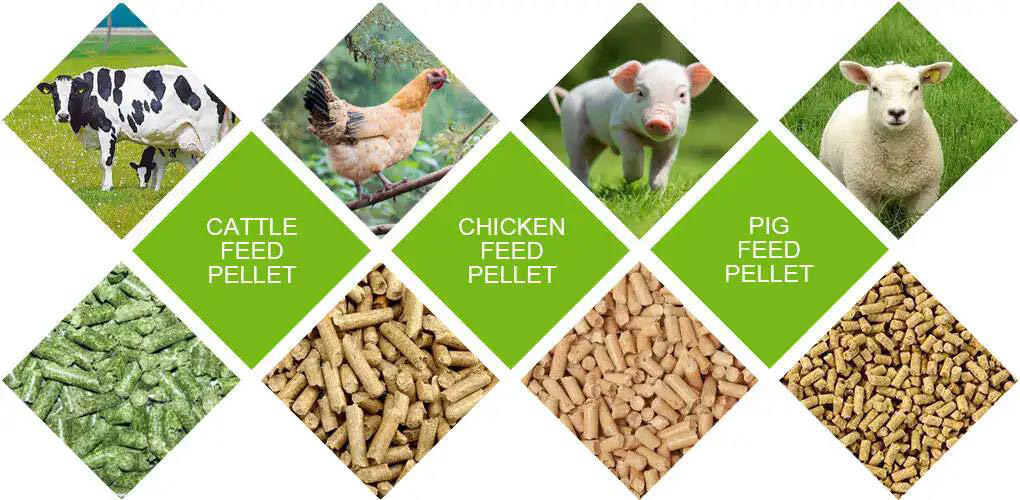Animal feed pellet mill
Animal feed pellet mill is a device specifically designed to grind animal feed pellets into powder. It plays a crucial role in the animal feed processing industry
Animal feed pellet mill Introduction


Features of Animal feed pellet mill
Versatility
Capable of handling various types and formulations of animal feed pellets to meet the nutritional needs of different animals.
Adjustable Fineness
Ability to adjust the fineness of the ground feed pellets to accommodate the digestive capacity and eating habits of different animals.
Efficient and Energy-saving
Possesses efficient grinding capability while employing energy-saving designs to reduce energy consumption.
Sturdy and Durable
Constructed with wear-resistant materials and a robust structure, ensuring a longer service life.
Ease of Operation
Designed with simplicity for easy operation and maintenance, allowing operators to handle it with ease.
Dust Control
Equipped with dust control devices to minimize dust generation and improve the working environment.
Strong Adaptability
Can accommodate feed pellets of different sizes and shapes, offering a wide range of applications.
Improved Feed Utilization
By grinding feed pellets into powder, it increases their surface area, enhancing the digestive absorption rate and utilization efficiency of animals.
High Production Efficiency
With high production capacity and automation, it can meet the demands of large-scale feed production.


Structure of Animal feed pellet mill
Feeding System
It delivers the raw material feed pellets into the interior of the mill, typically including a feeding port, conveyor belt, or screw feeding device.
Grinding Chamber
This is the core part of the mill where the feed pellets are ground into powder, usually comprising grinding discs or rollers.
Screening Device
It controls the particle size of the powder, allowing only particles of the required size to pass through and be discharged.
Discharge System
It transports the ground powder out of the mill, typically including a discharge port, conveyor belt, or screw discharge device.
Power System
It provides the necessary power for the operation of the mill, usually driven by an electric motor or diesel engine.
Control System
It regulates and monitors the operational parameters of the mill, such as feeding rate, grinding pressure, and discharge speed.
Cooling System
Some high-performance mills may be equipped with a cooling system to lower the temperature during the grinding process, ensuring stable operation of the equipment.


Advantages of Animal feed pellet mill
Increased feed utilization
Grinding feed pellets into powder increases their surface area, enhancing the digestibility and absorption rate of feed by animals, thus reducing feed wastage.
Improved feed uniformity
The pellet mill can uniformly grind feed pellets into powder, ensuring a balanced distribution of various nutrients in the feed and guaranteeing animals receive balanced nutrition.
Enhanced feed quality
The grinding process removes large particles and impurities from the feed, improving its purity and quality.
Enhanced animal health
Finer, more uniform feed powder aids in better digestion and nutrient absorption by animals, reducing the occurrence of digestive disorders and diseases.
Ease of operation
Modern pellet mills are designed with simplicity for easy operation and maintenance, allowing operators to easily handle them.
Increased production efficiency
With efficient grinding capabilities and automation, they can meet the demands of large-scale feed production, thereby enhancing production efficiency.
Cost savings
By improving feed utilization and quality, feed wastage is reduced, resulting in lower feed costs.
Environmentally friendly and energy-saving
Adoption of energy-saving designs reduces energy consumption and environmental pollution.
Application of Animal feed pellet mill
Typically, the production of feed pellet mill uses raw materials such as corn, soybeans, wheat, and other nutrients as the formula. Our feed pellet mill are specially used to produce feed for poultry, livestock, pigs, horses, cattle, sheep, chickens, ducks, goose and other animals.For different animals, with different growth cycles, (chicks, suckling pigs, calves, etc.), the feed pellet size required is different, but our feed production line only needs to replace ring molds with different apertures or use a pellet crumbler to reach the required size.

Parameter of small feed pelletizer
| Model | Capacity | Main Motor Power | Feeder Motor Power | Conditioner Power | Dia. of Ring Die | Pellet Size |
| SZLH250 | 1-2T/H | 22KW | 0.75kw | 1.5kw | 250mm | 2-12mm |
| SZLH320 | 3-4T/H | 37KW | 1.5kw | 2.2kw | 320mm | 2-12mm |
| SZLH350 | 5-7T/H | 55KW | 1.5kw | 3kw | 350mm | 2-12mm |
| SZLH420 | 8-12T/H | 110KW | 1.5kw | 7.5kw | 420mm | 2-12mm |
| SZLH508 | 10-18T/H | 160KW | 2.2kw | 11kw | 508mm | 2-12mm |
| SZLH558 | 15-25T/H | 180KW | 2.2kw | 11kw | 558mm | 2-12mm |
| SZLH678 | 20-30T/H | 220KW | 2.2kw | 11kw | 678mm | 2-12mm |
| SZLH768 | 25-42T/H | 280KW | 2.2kw | 11kw | 768mm | 2-12mm |








